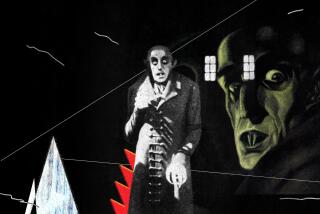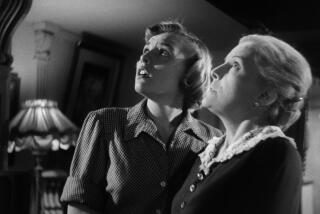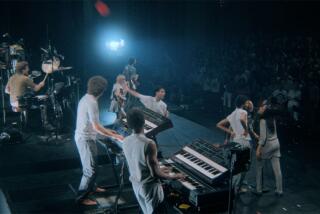Silents, Please --A Moviegoer Looks Back
- Share via
The Orpheum Theater, between 8th and 9th streets on Broadway, is a time machine.
We walked into it one night last week and were back in the ‘20s. We had come to see the 1927 silent movie “The Student Prince,” starring Norma Shearer and Ramon Novarro.
The showing was one in the third annual “Last Remaining Seats” program sponsored by the Los Angeles Conservancy. Essentially, the theater had hardly changed since I patronized it on Saturday afternoons as a schoolboy. But it was grimy. Graffiti covered the men’s rest room. It was warm and humid. But the Renaissance and Gothic grandeur remained intact. We sat in the balcony between the two heavy chandeliers. It occurred to me that it would not be a good place to be in an earthquake.
My anxieties dissolved when the organ rose, front and center, and Gaylord Carter turned to face the almost sellout audience. Incredible. He had turned 84 that day. He had played throughout the first run of “The Student Prince” at the Million Dollar Theater in 1927. Here he was to play it again.
The first short subject was “Precious Images,” a powerfully nostalgic montage of clips from 60 years of movies. They flashed by at less than a second each; we hadn’t time to say the names of the stars or the movies; yet every clip inspired a surge of recognition. So profound a part of our lives the movies have been.
A Harold Lloyd short began with a simple introduction: “The plot--A boy is in love--the rest just happens.” How many movies have been based on little more than that. Lloyd really loves his Model-T Ford roadster, which of course turns against him. Carter played with sympathy.
For “The Student Prince,” Carter improvised from Sigmund Romberg’s score for the musical, the lyrical waltzes, the stirring marches, the fraternal drinking song. I had wondered how they could make a silent “Student Prince.” They didn’t. Obviously, it had been anticipated, in 1927, that the film would be accompanied by an orchestra, an organ, or at least a piano. Despite the playful touches of director Ernst Lubitsch, without the accompaniment of Gaylord Carter the film would have been an intolerable bore.
Imagine a beer hall full of rowdy students singing Romberg’s drinking song in silence. Synchronizing with their lips, Carter created the illusion of raucous male voices. He never rested. When the camera rose to show the castle on a hilltop, he played castle music--if there is such a thing. When Shearer and Novarro chased each other through fields of wildflowers, he sent up a swirl of romantic airs.
I was reminded of my cousin Donald. In the 1920s he played the piano for Saturday night movies in the Women’s Club of Shafter, a farm center northwest of Bakersfield. Shafter was the sticks. It didn’t even have a moving picture theater. Donald couldn’t play the piano; he played a player piano. But with his fewer skills, he tried as hard as Carter to match the music to the scene. Invariably, when someone was dying, he played “Nearer My God to Thee.” It was a much-worn roll.
Shearer was not a great actress. She wasn’t even beautiful. Her face was too long. So was her nose. But in “The Student Prince” she is required only to be coy, passionate and heartbroken. Novarro had only to express youthful charm, buoyancy and naivete. Both were equal to those tasks.
Since you will probably never see the movie, it can’t hurt to disclose the plot. Novarro is a crown prince. He is raised behind palace walls. As a young man he is sent to Heidelberg, where he falls in with the students and learns to drink beer chug-a-lug. He falls in love with Shearer, an innkeeper’s niece. When the old king dies, his last request of Novarro is that he marry a princess and carry on the family line. Novarro, urged on by the king’s advisers, gives his word. Finally he goes back to Heidelberg to tell Shearer that, though he may never see her again, he will never forget her. Believe me, that takes music.
Tonight at 8 the conservancy is showing “Bringing Up Baby,” with Katharine Hepburn and Cary Grant, at the Westlake, across from MacArthur Park.
Don’t miss it if you can.
More to Read
The biggest entertainment stories
Get our big stories about Hollywood, film, television, music, arts, culture and more right in your inbox as soon as they publish.
You may occasionally receive promotional content from the Los Angeles Times.










